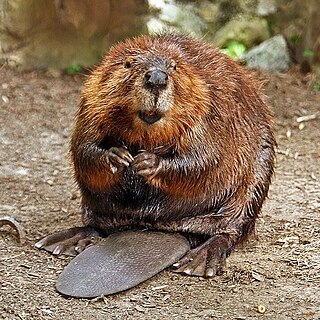
Beavers are large, semiaquatic rodents of the Northern Hemisphere. There are two existing species: the North American beaver and the Eurasian beaver. Beavers are the second-largest living rodents, after capybaras, weighing up to 50 kg (110 lb). They have stout bodies with large heads, long chisel-like incisors, brown or gray fur, hand-like front feet, webbed back feet, and tails that are flat and scaly. The two species differ in skull and tail shape and fur color. Beavers can be found in a number of freshwater habitats, such as rivers, streams, lakes and ponds. They are herbivorous, consuming tree bark, aquatic plants, grasses and sedges.

A pika is a small, mountain-dwelling mammal native to Asia and North America. With short limbs, a very round body, an even coat of fur, and no external tail, they resemble their close relative, the rabbit, but with short, rounded ears. The large-eared pika of the Himalayas and nearby mountains lives at elevations of more than 6,000 m (20,000 ft).

Castoridae is a family of rodents that cointains the two living species of beavers and their fossil relatives. A formerly diverse group, only a single genus is extant today, Castor. Two other genera of "giant beavers", Castoroides and Trogontherium, became extinct in the Late Pleistocene.

Castoroides, or giant beaver, is an extinct genus of enormous, bear-sized beavers that lived in North America during the Pleistocene. Two species are currently recognized, C. dilophidus in the Southeastern United States and C. ohioensis in most of North America. C. leiseyorum was previously described from the Irvingtonian age but is now regarded as an invalid name. All specimens previously described as C. leiseyorum are considered to belong to C. dilophidus.
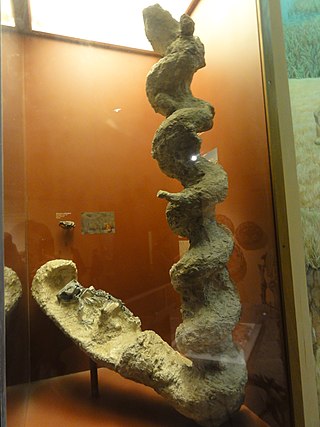
Palaeocastor is an extinct genus of beavers that lived in the North American Badlands during the late Oligocene period to early Miocene. Palaeocastor was much smaller than modern beavers. There are several species including Palaeocastor fossor, Palaeocastor magnus,Palaeocastor wahlerti, and Palaeocastor peninsulatus. The animals first became known on grounds of their fossilized burrows, the "Devil's corkscrews".
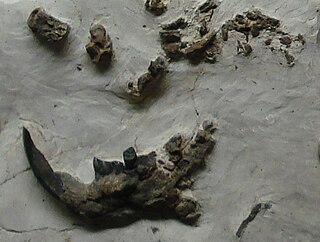
Steneofiber is an extinct genus of beavers from the Miocene. They contain several species of beavers. Amongst them are S.barbouri, S.complexus, S.depereti, S.fossor, S.gradatus, and S.hesperus. Their various species are found all the way from the eastern end of the Iberian peninsula to southern Japan. S.depereti has been found in northwest Germany.
The zygomasseteric system in rodents is the anatomical arrangement of the masseter muscle of the jaw and the zygomatic arch of the skull. The anteroposterior or propalinal (front-to-back) motion of the rodent jaw is enabled by an extension of the zygomatic arch and the division of the masseter into a superficial, lateral and medial muscle. The four main types are described as protrogomorphous, sciuromorphous, hystricomorphous, and myomorphous.
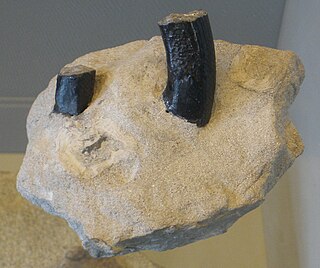
Anchitheriomys is an extinct member of the beaver family, Castoridae. It inhabited North America and Eurasia during the middle Miocene. The name of the genus comes from Anchitherium, an extinct genus of horses, and the Greek word for mouse, μῦς (mys), thus meaning "Anchitherium's mouse", because the fossils of both genera usually co-occur.
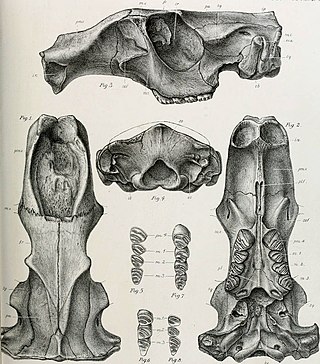
Trogontherium is an extinct genus of Eurasian giant beavers that lived from the Late Pliocene to the Late Pleistocene. Fossils of Trogontherium have been found across northern Eurasia, from Western Europe to China and Siberia.

Tapirus californicus, the California tapir, is an extinct species of tapir that inhabited North America during the Pleistocene. It became extinct about 13,000 years ago.

Tapirus merriami, commonly called Merriam's tapir, is an extinct species of tapir which inhabited North America during the Pleistocene.
This paleomammalogy list records new fossil mammal taxa that were described during the year 2013, as well as notes other significant paleomammalogy discoveries and events which occurred during that year.

Albicetus is a genus of stem-sperm whales that lived during the Miocene Epoch, around 15 million years ago, and was discovered in Santa Barbara, California in 1909. It was categorized for decades as belonging to a group of extinct walruses erroneously thought to be sperm whales. It was named Albicetus, meaning "white whale", is a reference to the leviathan in Herman Melville's classic 1851 novel Moby-Dick.
This paleomammalogy list records new fossil mammal taxa that were described during the year 2017, as well as notes other significant paleomammalogy discoveries and events which occurred during that year.
This paleomammalogy list records new fossil mammal taxa that were described during the year 2016, as well as notes other significant paleomammalogy discoveries and events which occurred during that year.
This paleomammalogy list records new fossil mammal taxa that were described during the year 2018, as well as notes other significant paleomammalogy discoveries and events which occurred during that year.
This paleomammalogy list records new fossil mammal taxa that were described during the year 2020, as well as notes other significant paleomammalogy discoveries and events which occurred during the year.
This paleomammology list records new fossil mammal taxa that were described during the year 2022, as well as notes other significant paleomammalogy discoveries and events which occurred during 2022.
This article records new taxa of fossil mammals of every kind that are scheduled to be described during the year 2023, as well as other significant discoveries and events related to paleontology of mammals that are scheduled to occur in the year 2023.












